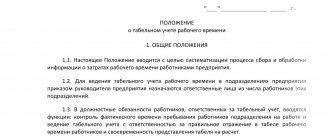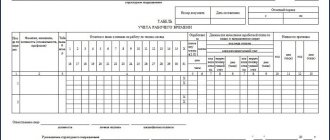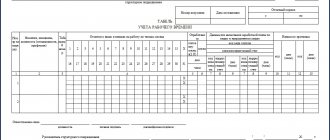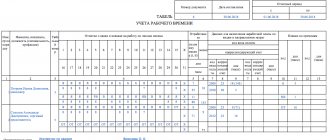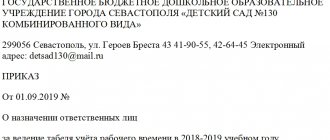Designations
If an employee is not present and the reason for this phenomenon is unknown, then “NN” is usually written on the time sheet. If it turns out that the reason is the employee’s illness (and sick leave was provided), then in place of these “NN” the designation “B” is put down.
And if there were no valid reasons for missing a working day, then the designation “NN” should be replaced with “PR”, which means that there was absenteeism. There are other designations for each day of work and type of activity.
Responsibility
Correct completion of the time sheet is the responsibility of the person authorized to do so. However, inspectors often record various types of violations:
- discrepancy in information regarding a person’s earnings;
- incorrect use of codes;
- incorrect calculation of payments based on sick leave.
For these mistakes, the official may be brought to administrative liability, implying a fine of up to 5,000 rubles. But if the company does not issue a working time document at all, then the manager can be fined 50,000 rubles.
Purpose
The work time sheet, according to labor legislation, is filled out and submitted at least twice a month (this is clearly stated in Article 136 of the Labor Code of the Russian Federation). It is according to his data that employees of the organization are paid wages.
However, quite often there are situations when an employee is absent from work for unknown reasons. If you wait for them to clear up and hand in the report card later, this will be a violation of the Labor Code. Therefore, they resort to drawing up correction sheets. The form for the corrective time sheet in commercial organizations is presented in forms T-12 and T-13. And in budgetary institutions, standard form number 0504421 is used. However, the latter can also resort to T-13.
Important! The difference between a corrective time sheet and the main one is the type designation in the header of the document (main or corrective), as well as in the numbering. There is no numbering in the main timesheet, while corrective documents, in addition to their identification, always have a serial number.
Changes to the same paper can be made repeatedly by one or several employees. Therefore, the full name of the document may be “Corrective time sheet No. 1, adjustment number - 2.” This means that the second adjustment option is received for the first time sheet.
In this case, the data from the corrective document is entered into the main paper. For example, the designations “NN” (unknown reason for absence) are replaced by “PR” (absenteeism) or “B” (work hours missed due to illness).
It is more convenient to do this electronically, since the replacements can be quite extensive. If you need to correct one or two letters, then you can get by with a simple correction in the existing paper. However, there are nuances here.
Working time accounting in 1C:ZUP
Different companies have their own ways of recording working hours. They directly affect the procedure for entering data on working hours into the 1C:ZUP program, as well as the further payment of wages to employees.
Accounting for mining can be carried out in two main ways:
- Recording of hours worked. This method assumes that a continuous recording (registration) of real mining is carried out. In addition, this method of accounting for working hours involves not only recording existing deviations, but also subsequent filling out a report card. The formation of the mandatory report form (Table T-13) is carried out on the basis of the recorded actual data.
- Accounting for deviations. In this case, the following data is entered into the 1C: ZUP program: discrepancies with the employee’s original schedule, for example. absenteeism, absenteeism, vacations taken, etc. When accounting for deviations, maintaining a time sheet is not mandatory, and registration of all identified deviations is carried out separately.
Please note: the 1C:ZUP program recommends using the method of introducing deviations.
The employment order for each specific employee contains data on his work schedule. The basis for providing such information is the production calendar. The latter, in turn, takes into account pre-holiday days, holidays, and weekends.
In order to check the production calendar in the 1C:ZUP program, you need to go to the “Settings” section, and then select the “Production Calendars” tab. Alternatively, this can be done by accessing the “Employee Work Schedules” option.
If Internet support is enabled in the 1C program, the production calendar is updated automatically.
The production calendar is the basis for determining the work rate. In order to display a table of temporary norms, as well as a list of working days, weekends, and calendar days for a specific quarter or month, you must use the “Print” button.
In the 1C: ZUP program, the “Five Days” schedule has already been created by default. In order to view the list of all available graphs, the user needs to refer to the “Graphs” option.
In our case, the open “Five Days” schedule contains information about weekends and working days (based on the loaded calendar).
The time sheet is filled out based on the data discussed above. if necessary, the 1C user can create additional charts independently. For example, based on established accounting requirements, allocate shifts and night hours for your organization. In addition, it is possible to specify additional settings.
1C software capabilities allow you to implement even the most complex schemes for recording time worked by employees - the setup is quite simple.
By accessing the “Change schedule properties” option, the 1C:ZUI operator can configure the working hours, and also, if necessary, set his own parameters. The figure shows a replaceable version of the schedule.
Filling out the time sheet is carried out based on the settings previously specified by the user. In addition, the working time of a particular employee will be taken into account when calculating wages.
Please note that upon hiring, each new employee is given a schedule. In this case, you can change the data specified earlier. To do this, the user needs to refer to the “Personnel Transfer” document.
In addition, the capabilities of the 1C program allow the user to change the schedule for a selected group (list) of employees. To do this, you need to create a new personnel order by accessing the “Personnel” section and selecting the “Hiring, transfers, dismissals” tab.
Please note that the ZUP program makes it possible to enter an individual schedule, for example, if a certain employee needs to change working conditions for a specific period of time. This includes setting shortened days, as well as adjusting weekends and working days.
In this case, the calculation of the temporary norm will not be carried out on the basis of the main schedule (which in turn is indicated in the corresponding order. The norm will be determined on the basis of updated data.
To enter an “Individual Schedule”, the ZUP user needs to go to the “Salary” section, then select the “Time Accounting” tab. Next, from the drop-down list, you need to select the employees who will be affected by the change. Thus, in the tabular part of the document a new schedule is set for a group of workers.
If an employee does not come to work for any reason, this must be reflected in the program. Employee absenteeism is reflected by entering deviation documents. The latter are displayed in the timesheet in automatic order.
Despite this, with this method of accounting, the timesheet is not entered as a separate document. The user needs to present it in the form of a report.
Please note that this option is available not only in the “Salaries and HR Management” program, but also in the 1C: Accounting program.
Corrections
If the need for adjustment has been formulated in writing by the timekeeper, and the main time sheet has been printed and filled out, then changes can be made to it without reprinting. Corrections are acceptable for this purpose. They are made by crossing out incorrect data and writing the correct data next to it. However, the margins should include:
- Link to the correction sheet, with its number and date of preparation. It can be formulated as “Corrections have been made in accordance with...”. If the phrase does not fit completely, then simply the name of the document, with its number and date, is enough.
- Signatures of all persons who signed the main report card.
- Deciphering signatures.
- Positions of employees responsible for filling out the paper, as well as the head of the organization.
Related documents
Each specific case must be considered individually, but explanatory notes from the employee or employees are usually attached to the corrective time sheet. Most often, this phenomenon is associated with the untimely presentation of sick leave or the inability to provide it. In this regard, prudent employers have introduced the practice of clarifying these points over the phone with an employee who did not show up for work.
However, according to the Labor Code, you cannot put code “B” in a document without verifying the existence of a sick leave certificate. In addition, a sick employee does not always have the opportunity to report his situation.
In addition, the corrective time sheet must always be accompanied by a memo drawn up by the employee responsible for filling it out.
Important nuances
While on a business trip, the employee maintains a time sheet independently. For this he is entitled to an additional payment, as the number of work responsibilities increases. Therefore, if for some reason it is necessary to make changes to such a timesheet, then it must be completed by the employee himself, since in this case it is he who is responsible for the correctness of the specified data.
If adjustments are needed for several employees, then it is more convenient to prepare an adjustment sheet for each employee separately. This way you can minimize the possibility of errors in accounting.
Possible mistakes
In court proceedings there are often cases in which:
- There is no note on the employee's absenteeism on the report card. Every day, the timekeeper must enter an o if the employee is not there, and not try to find out the reason and leave filling out “for later.”
- The employee presented sick leave from the previous period or the sick leave was returned. This behavior is detrimental to the employer.
- The report card does not contain the manager's signature. Or, in addition to the time sheet, no additional evidence was provided of the employee’s absence from the workplace.
How long is it stored?
The storage time of a document directly depends on its functionality:
- If the corrective time sheet is used only as a document that contains information about the company’s activities, then it must be kept for a year.
- If it is directly related to the calculation of taxes for the organization (and this happens in the vast majority of cases), then the storage period increases to 4 years.
- If it is the main document for payroll, then it must be preserved for at least 5 years.
- And if the organization has harmful or dangerous working conditions (which impose an obligation on employees to work in them), then the document is stored for at least 75 years.
Incorrect execution of the corrective work time sheet, in accordance with Part 1 of Art. 5.27 of the Code of Administrative Offenses of the Russian Federation, can cost the employer up to 80 thousand rubles.
Meanings and order of compilation
A corrective time sheet (hereinafter referred to as KTURV), in accordance with the norms of the current labor legislation, is needed so that a personnel specialist can make changes to a document that has already been filled out. The main requirement that must be observed is the novelty and relevance of the newly offered information.
Registration and delivery are carried out at least twice a month (Article 136 of the Labor Code of the Russian Federation). It is on the basis of this data that the company’s employees are paid salaries.
from his immediate place are quite common (the reasons being unclear).
If the personnel officer has to wait for the situation to be clarified and only then submit the finished document to the archive, this will be considered a violation of labor legislation. That's why companies resort to registering KTURV.
The forms are presented in forms T-12, T-13. And if the paper is kept in a budgetary institution, a specialized template No. 0504421 (although some organizations use the T-13 form).
The basic difference between KTURV is that the “header” contains slightly different designations. It states that the paper is of a corrective nature.
Another important role is played by the different numbering of the paper. Basically, KTURV does not take it into account, but in the corrective one there are always serial numbers. Otherwise, the report card has the same content as the main paper, since it completely repeats it.
Now it’s worth considering the time intervals for the preparation and operation of the paper. The paper can be received by the accounting department within six months from the moment the main time sheet was filled out and closed. Even in this case, salary recalculation measures are mandatory on the part of the accounting department. Although, in accordance with the recommended time sheets, the timekeeper is responsible for compiling it and submitting it no later than the 5th.
Each situation must be considered individually , however, an explanatory note is traditionally attached to the document. This circumstance is directly related to the fact that the sick leave is submitted late.
Therefore, especially prudent employers have introduced the practice of clarifying detailed points with employees who did not show up for work by telephone.
Another feature of the document is that it is always accompanied by a memo, which is compiled by the employee responsible for filling out the paper.
If an employee is on a business trip, he is responsible for maintaining this document independently.
For performing such functions, he has the right to count on additional payment in connection with an increase in the number of work responsibilities. So, if any changes are required to such a timesheet, the employee himself is responsible for the paperwork, since he is the one recognized as the responsible person for the correctness of the information entered.
If adjustments are made for several employees at the same time, it is most advisable to draw up the KTURV for each of them separately, this will help minimize errors.
If we talk about blots, shortcomings and errors that arise in the process of filling out the KTUV, they consist mainly in the following points:
- absence in the completed form of a note about the fact of absenteeism of the employee (if the employee fails to show up at the place of direct performance of work duties, “NN” should be entered daily instead of delaying and waiting for clarification of the circumstances);
- presentation by the employee of sick leave for the previous period or its return, which clearly does not benefit the employer;
- the improved document does not contain the signature of the manager;
- failure to provide supporting evidence as to why exactly the employee was absent from work.
The period during which a document is stored is directly dependent on the functions it performs:
- if the use of KTURV is carried out exclusively as a document containing data on the activities of the organization, it is subject to mandatory storage for an annual period;
- if the document has a direct relationship with the calculation of tax contributions, which in practice occurs quite often, the storage duration increases to 4 years;
- if the corrective time sheet is presented as the main document used for calculating wages, it is retained for a period of 5 years;
- If the company has particularly harmful or extremely dangerous working conditions, storage in the archive is carried out for a period of 75 years.
Making corrections
If there was a written wording on the part of the timekeeper related to the need to make adjustments , and the main TURV was completed, it is possible to make changes without the need to retype.
This process occurs by crossing out false information and simultaneously establishing true data.
The fields must contain the following elements:
- a link to the document with amendments, containing information about the number, date of compilation (if it is not possible to place this phrase in full, you will only need the name of the document , its number value, and the day of compilation);
- “autographs” of all persons who took part in the process of signing the basic report card;
- decoding of all signed signatures ;
- positions held by the persons responsible for filling them, and then the scope of work (actual position) of the manager is indicated.
Changes to the same document can be made several times , both for a specific employee and for several. Information from the corrective documentation must be included in the main part.
It is most convenient to complete this registration electronically, since replacements on paper can be problematic . If you only need to correct a few letters, you can get by by simply making corrections to the existing document.
Sample form and rules
In practice, a certain procedure has been developed for making changes to the specified data, which is recommended to be followed unconditionally.
- First, the fact that adjustments are necessary is established. For example, this may be due to the excessively late provision of the evidence base on the basis of which the document is filled out.
- Then an explanatory note from the employee who is responsible for maintaining KTURV. This element is not considered mandatory even in government organizations. However, experts give recommendations on its preparation in any case when corrections take place.
- Drawing up the document itself. This process is carried out in accordance with the same rules as the main paper. The only difference is the inclusion of the word “corrective” within the title.
Regarding the structure and content of the document, several variable approaches are used.
- The need to completely repeat the content of the main paper that was drawn up earlier. Of course, the corrections made should be taken into account. This position is enshrined in the resolutions of the Ministry of Finance of the Russian Federation .
- The document includes corrections only. That is, directly data on those employees whose information was subject to change.
Due to the lack of clear regulations regarding the algorithm for filling out the KTUV, personnel officers were given freedom of action, since incorrectly filling out the document does not entail any serious consequences in the form of punishments. But if we take into account the presence of clarifications from the Ministry of Finance of the Russian Federation, it is recommended to use the first approach to resolving this issue.
You should also remember the fact that corrective documents are filled out based on personnel numbers, and not on specific individuals. This is due to the fact that if an employee combines two positions within the walls of one organization (that is, performs part-time job duties), two personal cards are filled out for him, and two numbers are assigned.
Thus, the corrective document for recording working hours is important and is widely used in the activities of public and private sector enterprises.
It allows you to easily make changes to documents and comply with the legislative framework regarding filling out basic papers. There is no standard document template, however, there are several templates that specific organizations adhere to to simplify the process of maintaining the papers in question.
For more information on preparing the corrective report card, see the video below.
Filling Features
Timekeepers often have to make notes on the document indicating deviation from the standard operating mode. It is important to remember that this can only be done on the basis of supporting documents (medical certificate, etc.).
But most often, difficulties with document preparation arise if a subordinate goes on a business trip. In order to avoid mistakes, personnel officers should know some nuances:
- The employee is on a work trip on holidays and weekends, which means he is paid double. "KM" is entered.
- The subordinate is on vacation. This means that “OT” is placed in the empty cells corresponding to weekends. If there are non-working holidays, they should be excluded.
- A new employee appears. Therefore, in all empty cells for dates that preceded his employment, you need to put “XX”. These symbols should be used when the employee has already left and the monthly report card has not yet been closed.
Before you begin the duties of maintaining employee timesheets, you should read the relevant instructions and learn all the nuances of registration. After all, mistakes made in this case affect, first of all, staff wages, the number of absenteeism and the duration of vacation. All documentation provided by employees should be checked very carefully.
Timesheet - what is it?
First of all, you need to know what a time sheet itself is. This is a document in which complete information is entered on how many days and hours during the month an employee of the organization actually carried out his labor functions. The report card reflects information about each absence from the workplace, absenteeism and their reasons. At the end of the month, it is on the basis of the timesheet that the wages that must be paid to the employee are calculated.
The following report forms are currently used:
- T-12, used for manual filling.
- T-13, used in enterprises that use methods for automatically monitoring the presence of employees at the workplace (automatic turnstiles, etc.).
- 0504421, used in government agencies and budgetary organizations.
T-12 and T-13 were approved by a decree of the State Statistics Committee of the Russian Federation in 2004 and, in principle, contain the same set of data. Formally, as of January 1, 2013, these forms are no longer mandatory (information of the Ministry of Finance of Russia No. PZ-10/2012). But since the employer is obliged to keep track of working hours and pay wages to employees, most enterprises do not develop their own forms for time sheets, but continue to use the previously approved T-12 and T-13.
Form 0504421 was approved in March 2015 by order of the Ministry of Finance of the Russian Federation No. 52n and remains mandatory for use.
Filling out a time sheet
Within the time frame established by the institution’s document flow procedure, the employee responsible for maintaining the Timesheet (f. 0504421) reflects the number of days (hours) of absences (appearances), as well as the number of hours by type of overtime (substitution, work on holidays, night work and other types) with recording them in the appropriate columns. The completed Timesheet (f. 0504421) is signed by the person entrusted with maintaining the Timesheet (f. 0504421).
The time sheet (f. 0504421) is maintained by persons appointed by order of the institution, monthly for the entire institution or in the context of structural units (divisions, divisions, faculties, laboratories and other structural units) of separate units (branches).
The company can use standardized forms or develop the form independently.
Most often, the unified form of the report card is modified. Several additional graphs and codes are added.
In the document, each position is reflected in two lines. The top one will contain a symbol in the form of a code, the bottom one will contain how many hours the employee worked.
Each type of work or rest time has its own designation (alphabetic or numerical). Attendance/no-appearance codes are written on the title page of T-12.
They are also used if T-13 is filled. It is advisable to use letter codes (they are easier to remember).
Any note about the reasons for the employee’s non-appearance and about the special work schedule must be affixed if there is a supporting document (certificate of incapacity for work, vacation order, etc.)
For example, an employee did not go to his workplace, and you do not know the reason. Until the timesheet is submitted, the no-show column is left blank.
We invite you to familiarize yourself with: Sample purchase and sale agreement for building materials 2021
If a person brings a supporting document, then a code is placed on its basis. If such a document is not received, the code “NN” is entered (failure to appear for an unknown reason).
The report card is compiled in a single copy, which is signed by an authorized person, the head of the unit and an employee of the human resources department.
The document must be stored for 5 years. If the working conditions are harmful and dangerous, then the period will be 75 years. Documents created after 2003 are stored for 50 years (Order No. 558 of August 25, 2010).
Let's present a sample of filling out a summary sheet of working time. Let's figure out how to fill out the T-13 form if you use the continuous method.
At the top they reflect the name of the company, the full name of the entrepreneur and the structural unit. These could be departments such as sales, marketing, production.
Next, you should enter the OKPO code according to the all-Russian classifier of companies, which is in the Rosstat database. This code is represented by 8 digits for legal entities and 10 for individual entrepreneurs.
The document is drawn up within a month (from its beginning to its end). When reflecting data about employees, a separate line is filled in for each of them.
Indicate a serial number that is assigned to all employees and is used in all accounting certificates.
This number will remain with the citizen even for a certain time after termination of the employment contract. Write the person's full name and position.
| I | Shows turnout |
| IN | Weekend |
| TO | The time the person spent on a business trip |
| FROM | Vacation time |
It is necessary to indicate the number of days and hours for the reporting period. The fifth column will contain the number of days and hours that the employee worked for half the month.
Column 6 reflects the days and hours for the month. Specify the data for calculating earnings in this way: Wage type codes determine what transfers will be made. The cipher used is digital. Our example reflects wages and vacation pay.
The expenses will be debited from the accounting account to the reflected payment type. Here, account one.9 of the column will reflect how many days were worked for a specific type of payment.
If all employees are charged one type of payment, then its code is written at the top. Columns 7, 8 are skipped, entering only how many days and hours worked in column 9. Fill in the data on no-show. Codes are entered to reflect the reason for the person’s absence. Then, authorized persons sign.
This document must be completed by an authorized employee. If a company has more than one division, and work time is taken into account for each such department, then several responsible persons are appointed.
The manager can appoint any company specialist he wishes. Even watchmen can be appointed responsible.
The employee who will be responsible for drawing up the accounting sheet must be appointed by order.
It must contain the full name of such a person and the full name of the deputy who will fill out the form in the absence of the responsible employee. If there is no such order, then the additional obligation of the employee to keep a time sheet should be reflected in the employment agreement.
We suggest you read: Appealing a court order: how to challenge a judge’s decision
Otherwise, management does not have the right to require the employee to fill out a working time document.
Since large companies appoint several responsible persons, they must fill out the document within a month, then submit it to the head of the department for signature.
Such a boss will double-check the information and transfer the report card to the HR department. Personnel officers will verify the information, fill out their documentation based on it, and hand over the forms to the accountant.
If the company is not large, such a chain is not followed. The time sheet is kept by the personnel officer. It is then passed on to the accounting department.
| Time tracking | Where is information about how work time is used? |
| Settlements with employees for payment for work performed | This section is not always filled out, since other registers are often used in the form of a personal account, payroll statements |
| Complete registration | Appearances/no-appearances |
| Deviation registration | Absenteeism, overtime hours worked |
The company itself chooses which method is more suitable for it. If the company has a constant working day, then the second option is preferred.
If working time recording is summarized, then continuous registration is needed. Form T-13 is used in companies where there are special turnstiles - automated systems that will control the attendance of personnel.
The T-12 form is universal. The accounting sheet can be:
- in paper form;
- in electronic format;
- filled out in specialized accounting programs such as 1C.
More and more people are choosing the electronic form, as it is easier to correct.
The code that is set if a person goes on a business trip is K or 06. For the entire time of absence from the enterprise for this reason, the employee will receive an average salary (Article 167 of the Labor Code).
Usually such nuances are prescribed in the order. This means that a code can be written on the report card, which indicates the person’s presence at work or the code for his absence. They also reflect how many hours a person has worked.
For example, an employee returned from a business trip and worked 3 hours. The code “K”, “I” and the hour – “3” are written into the form.
The posted person is not obliged to comply with the work schedule of the enterprise to which he arrived, as well as the schedule that was established at the place of his main work.
If a person is absent and the reasons for his non-appearance are not known, then an NN is given. After establishing the reason for missing work, the PR is indicated.
What is a corrective time sheet?
The information in the time sheets may not correspond to reality as they are filled out. For example, a common situation is when an employee who did not show up for work for one or several days presented documents indicating that he was in the hospital. In this case, instead of the entered code NN (failure to appear for unknown reasons), it is necessary to enter code B (sick leave) on the report card. But if the salary is calculated 2 times a month, the report card may already be submitted. Moreover, the rules for maintaining it do not allow for either corrections or erasures.
Meanwhile, sick leave must be paid, and any expenses of the organization (including payments to employees) must be confirmed by primary documentation - otherwise the tax office will not take these expenses into account. What should a personnel officer and an accountant do in this case?
In this situation, an additional document is used - a correction sheet. As a rule, it is prepared at the end of the billing period separately for each employee for whom the adjustment is made. The corrective time sheet is usually accompanied by a memo from the person responsible for maintaining the time sheet. This note briefly explains the reasons why the corrective document was drawn up (a certificate of incapacity for work was provided for the previous period, sick leave was withdrawn, etc.).
Based on the corrective sheet, if necessary, the accrued salary is recalculated. HR officers usually draw up this document precisely at the request of the accounting department, which needs to make changes to the employee’s payments.
How is an employee's working time calculated?
The law establishes two types of standards - a six-day work week (36 hours) and a five-day work week (40 hours).
That is, workers can work five days with an eight-hour work day, or six days with a six-hour day. Violation of them is allowed in rare cases - with summarized accounting or an irregular schedule. In the first case, the standards are applied in a larger period of time, for example, a quarter, half a year, etc. It turns out that in a shorter period of work, the fact may not correspond to the current standards, but it should not exceed the standards in the selected larger time periods.
https://www.youtube.com/watch?v=
For some workers, a reduced daily or weekly rate may apply. How exactly employees’ working hours should be taken into account must be recorded in the internal labor regulations. The timesheet must also reflect all the time when the employee did not work, but was registered at the enterprise.
Such periods may include:
- Annual paid vacation.
- Additional vacation.
- Leave without pay.
- Sick leave.
- Maternity leave and child care up to 1.5 years.
- Business trip.
- Downtime, etc.
The timesheet opens at the beginning of the month, and at the end of the month it is closed. In the middle of the month, the responsible person summarizes the interim results, reflecting the data for the first part of the work time. The document is signed by the head of the department and submitted to the HR department for verification. Then it is transferred to the accounting department for payroll calculation.
How to prepare a corrective time sheet
Correction of data regarding working time recording is usually made in the following order:
- It is established that an adjustment is necessary (for example, late provision of documents on the basis of which the time sheet is filled out);
- An explanatory note from the employee responsible for maintaining the time sheet is being prepared. This note is not mandatory even in public sector organizations, but experts recommend that it be compiled for each case when data is adjusted.
- The adjustment sheet itself is compiled directly. It is prepared according to the same rules as the main one. The only significant difference will be the inclusion of the name “Correcting” in the “Ticket Type” line. Also, if the form contains the value “Adjustment number”, it indicates the serial number of the timesheet, starting from 1 (in this case, the primary timesheet, previously submitted, is not taken into account in the numbering). Numbering is necessary for cases when several corrective time sheets are compiled for the same department at different times.
There are different approaches regarding what should be contained in the correction report:
- It must completely repeat the contents of the main report card submitted earlier. Of course, taking into account the corrections made. This position is shared by specialists from the Ministry of Finance of the Russian Federation, who have repeatedly given clarifications regarding the application of Order No. 52n since March 2015. However, the order itself does not contain a requirement for complete duplication of information contained in the main report card.
- The corrective time sheet contains only corrections - that is, information on those employees for whom the accounting data has changed. This approach to drafting is less common, but does not contradict the law and, therefore, can be used if desired. This is what some personnel officers do.
The lack of clear legislative regulation regarding the procedure for filling out the correction report card gives HR specialists a certain freedom of action, because no liability is provided for the incorrect completion of this document. But if we take into account the availability of clarifications from the Ministry of Finance of the Russian Federation, the first approach should be considered recommended.
It is also necessary to remember: corrective documents are filled out by personnel numbers, and not by specific individuals. The fact is that if an employee combines 2 positions at one enterprise, 2 personal cards must be filled out for him and 2 numbers assigned. When making an adjustment, accordingly, 2 separate time sheets are either drawn up for this employee, or in general he is indicated 2 times.
Regulations on recording working hours (filling sample)
The accounting period for the summarized accounting of working hours is a quarter. The actual hours worked by the employee are counted daily and cumulatively for the quarter. The total duration of actual work of a particular employee for the entire quarter should not exceed the normal number of working hours for the specified period for this category of employees.
3.16. The person responsible for maintaining time sheets in the department draws up a time sheet on paper twice a month: separately for the first half of the calendar month in one copy and separately the final time sheet for the entire calendar month in one copy.
Where or a sample of filling out the correction sheet
In the event that you just need a form of an adjustment report card, everything is simple: it can be obtained from any legal reference system containing orders that approved the forms of accounting reports.
Since the corrective time sheet is compiled according to the same rules as the main one, you can use the usual form already used at the enterprise. In the event that after 01/01/2013 the enterprise introduced its own report card form, it is enough to use this particular form.
If you need a sample of filling out an adjustment time sheet , then you can familiarize yourself with it on our resource. The document has been prepared in accordance with current legislation and meets all the requirements for it.
How to draw up a correction sheet?
Publication date 08/29/2018
Question to the auditor
The responsible employee submitted a report card, which indicated that the employee had been on sick leave since July 24, 2018. In August, the employee brought a sick leave certificate, and it indicated the period of incapacity for work from July 23, 2018.
How should the corrective time sheet be drawn up - only for this employee or for the entire department as a whole? Should the whole month be entered or just the day where the error is? Should the time sheet be accompanied by an explanatory note from the employee responsible for the time sheet?
If a person is on sick leave, but has not yet passed it, is it legal for him to put B on the report card or is it still correct to put NN, and then draw up a corrective report card?
The unified form of the Time Sheet (f. 0504421) for public sector institutions was approved by Order No. 52n of the Ministry of Finance of Russia dated March 30, 2015 (hereinafter referred to as Order No. 52n). The use of another form is not provided for by law.

